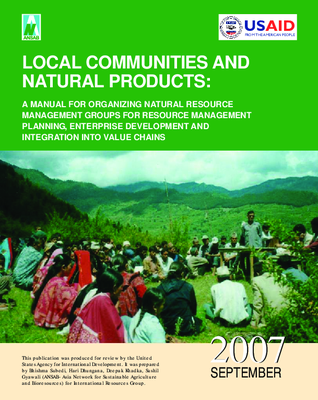Local Communities and Natural Products: A Manual for Organizing Natural Resource Management Groups for Resource Management Planning, Enterprise Development and Integration into Value Chains

This manual is intended to guide project planners through the process of integrating enterprises related to the production of goods from natural products into community-based natural resource management plans.
Key points in document
- This manual is intended to guide project planners through the process of integrating enterprises related to the production of goods from natural products into community-based natural resource management plans.
- The document provides a multi-faceted approach to enterprise development that utilizes methods such as community organizing, natural resource management planning, enterprise planning, and value chain integration.
- The document describes examples of community-based natural resource management projects in Nepal carried out by the Asia Network for Sustainable Agriculture and Bioresources (ANSAB).
- The manual provides guidance on planning for enterprises and their products, market development and planning, financial planning, policy and regulatory considerations, and the development of a business plan. ANSAB considers these steps key components for the creation of an enabling environment.
Information relevant to Learning Questions:
Are enabling conditions in place to support a sustainable enterprise?
- Stakeholder alignment
- Market demand
- Ownership
- Government requirements, policies for enterprises, business alliances
- Financial management capacity, technical capacity
- Equipment
- Policies for and enforcement of resource use
Does the enterprise lead to benefits to stakeholders?
- Increased income for participants
- Non-cash benefits
Do the benefits lead to positive changes in attitudes and behavior?
- Not addressed
Does a change in stakeholders’ behaviors lead to a reduction to threats to biodiversity (or restoration)?
- Residential and commercial development
- Agriculture and aquaculture
- Biological resource use
- Natural system modifications
Does a reduction in threats (or restoration) lead to conservation?
- Forest ecosystems
- Species

